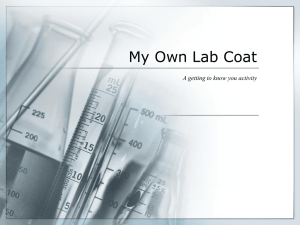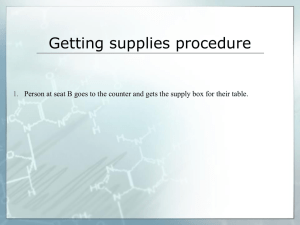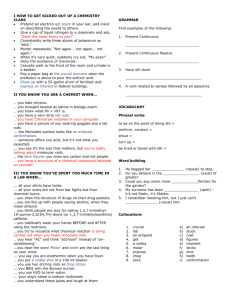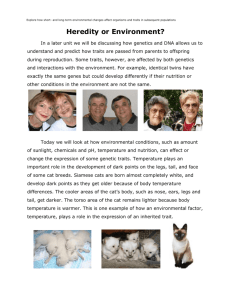Cambridge College
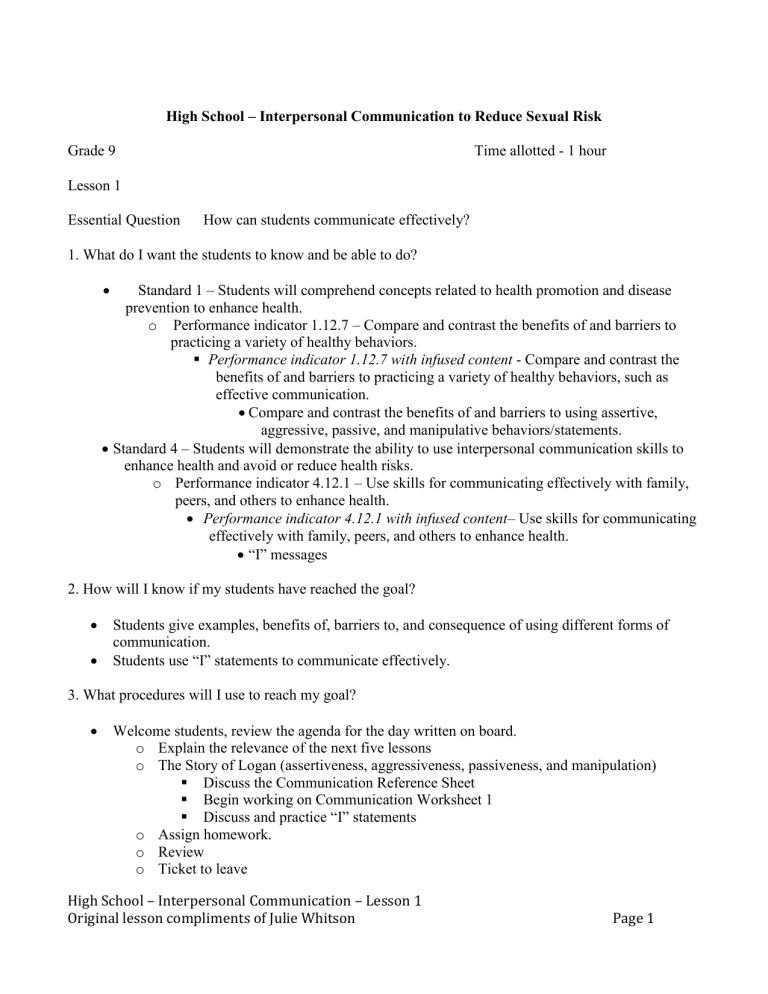
High School – Interpersonal Communication to Reduce Sexual Risk
Grade 9
Lesson 1
Time allotted - 1 hour
Essential Question How can students communicate effectively?
1. What do I want the students to know and be able to do?
Standard 1 – Students will comprehend concepts related to health promotion and disease prevention to enhance health. o Performance indicator 1.12.7 – Compare and contrast the benefits of and barriers to practicing a variety of healthy behaviors.
Performance indicator 1.12.7 with infused content - Compare and contrast the benefits of and barriers to practicing a variety of healthy behaviors, such as effective communication.
Compare and contrast the benefits of and barriers to using assertive, aggressive, passive, and manipulative behaviors/statements.
Standard 4 – Students will demonstrate the ability to use interpersonal communication skills to enhance health and avoid or reduce health risks. o Performance indicator 4.12.1 – Use skills for communicating effectively with family, peers, and others to enhance health.
Performance indicator 4.12.1 with infused content– Use skills for communicating effectively with family, peers, and others to enhance health.
“I” messages
2. How will I know if my students have reached the goal?
Students give examples, benefits of, barriers to, and consequence of using different forms of communication.
Students use “I” statements to communicate effectively.
3. What procedures will I use to reach my goal?
Welcome students, review the agenda for the day written on board.
o Explain the relevance of the next five lessons o The Story of Logan (assertiveness, aggressiveness, passiveness, and manipulation)
Discuss the Communication Reference Sheet
Begin working on Communication Worksheet 1
Discuss and practice “I” statements o Assign homework. o Review o Ticket to leave
High School – Interpersonal Communication – Lesson 1
Original lesson compliments of Julie Whitson Page 1
Introduce the skill of communication. o “The way we communicate with others is important to health. Knowledge, attitudes and skills determine individual health behavior. o Throughout this unit, we will be learning and practicing the skill of communication, as well as increasing our knowledge and examining our attitudes about sexual behavior and risks.”
Agenda for the next seven sessions o How to speak effectively to people o How to get what you want (whether it’s a job or a hug) without using other people and without getting used by other people. o How to respect yourself and other people at the same time o How to communicate your decisions o How to stand up for yourself without standing on top of someone else
Explain that formative assessments will be used each day to assess progress, as well as 2 summative assessments at the end of the unit. Homework, participation, and tickets to leave will also count toward final grade. o Performance task o Content quiz
Pass out red/yellow/green formative assessment tool to each student and explain that it should be folded as a triangle and used to provide feedback when asked.
Hand out the Communication Reference Sheet and use Part A in this way: o Ask a volunteer to read a definition aloud. o You may want to give an example and ask the class what the consequences might be. For example:
Aggressiveness
Example: You want to borrow your friend’s coat, so you take it. Or you ask, but if your friend says “no,” you call her a stingy creep.
Benefits: You might get to borrow the coat if you just take it.
Barriers: You probably lost a friend ... and maybe other friends, when your reputation gets out.
Example: Your friend asks to borrow your coat and you say “no” and shove him away from your locker.
Benefits: You do not lose the coat
Barriers: You may lose the friend… and maybe other friends, if they saw the argument.
High School – Interpersonal Communication – Lesson 1
Original lesson courtesy of Julie Whitson Page 2
Passiveness
Example: You are cold, you have lost your jacket, but you stand there shivering instead of asking to borrow your friend’s coat.
Benefits: None
Barriers: You will not get to borrow the coat. You might feel like a chicken. You will be cold.
Example: Your friend, who never returns things, asks to borrow your coat and you say “yes,” even though you know your mother is going to yell at you if you go home without it.
Benefits: None
Barriers: You lose the coat. Your mother yells at you. Your friend, who has now borrowed three things, considers you a wimp and feels like she can use you whenever she likes. You may get a reputation as an easy mark.
Manipulation
Example: You get your friend to lend you the coat by saying you will give it back when you get off the bus and then conveniently “forgetting.”
Benefits: You get the coat.
Barriers: You may not lose your friend this time, but if you keep it up, eventually he will “wise up.” He will not trust you. You may lose other friends as your reputation as a “user” gets around.
Example: Your friend asks to borrow your coat and you say, “Oh, I can’t.
The lock on my locker is broken” ... even though it is not.
Benefits: You keep the coat.
Consequences: As soon as your friend sees you open the locker, whether it is tomorrow or next week, you’ll have some quick explaining to do. Also, what would you do if he offers to fix the lock and realizes it is not broken?
Example: Your friend asks to borrow your coat. You lend it to her, so that when you want to borrow money from her she will “have to” let you.
Benefits: She owes you a favor.
Barrier: Your friend will be glad for the-moment. However, she may be annoyed when she discovers that you think she owes you a favor. She may not trust you after that.
Assertiveness
Example: You ask, “Is it OK if I borrow your coat?” If your friend says
“no,” you say “OK” and put on your own sweater.
Benefit: You have probably kept a friend. He may be willing to
Barrier: None
Example: Your friend asks to borrow your coat, but he has not returned
High School – Interpersonal Communication – Lesson 1
Original lesson courtesy of Julie Whitson Page 3
the last two things he has borrowed. You say “No, sorry. I wish you would give me back my money and my math book that you borrowed last week.”
Benefits: You might get your things back. You will not get in trouble with your father because you do not have your coat. You have probably kept a friend, who now will know he cannot use you.
Barriers: None
Hand out Communication Worksheet 1 o Complete only as much of it as you have time for, aloud as a large group. o You or a volunteer can read each situation aloud. o Ask the group which alternative is aggressive.
You may have to remind them of the definitions. When they agree on which alternative is “aggressive,” have them mark an “A.”
Continue with “passive,” (P), “manipulative,” (M), and “assertive,” (*). o Go on to the second situation, and so on. o After doing a couple aloud, give the class five minutes to complete the first page individually. Then discuss it aloud. o Assign the remainder for homework
Discuss “I” statements with the class. o Explain that “I” statements form the foundation of cooperation because they connect people, build trust and create healthier, more open and honest relationships.
Have students complete “I” Statements handout in class; or, alternatively, have pairs of students come to the head of the class to demonstrate “You” vs. “I” statements.
Using the worksheet, create scenarios. o For example, “Your boyfriend rarely wants to go on dates with you anymore and seems to be avoiding your phone calls.”
One student would demonstrate an (ineffective) “You” statement
Another would demonstrate an “I” statement.
As a group, discuss what the outcome would likely be with each.
Reflection o Review class content using mini white boards to formatively assess learning.
Ticket to leave: o On a slip of paper, write an “I” statement conveying your feelings about today’s lesson.
4. How can I improve this lesson?
High School – Interpersonal Communication – Lesson 1
Original lesson courtesy of Julie Whitson Page 4
Lesson Connections
Homework: o Complete the remainder of Communication Worksheet 1
Family Homework Exercise: Communication 1 (optional
Interdisciplinary Connections: ELA
Opportunities for Technology use: Use computers to find valid sources of information.
Opportunities for Parent Participation o Family Homework Exercise o Optional: Family Homework Exercise: Communication 1
Teacher resources needed :
Board/ flipchart to write agenda
“I” Statement teacher information packet
Communication Worksheet 1 answers
Solo plates/ mini white boars for formative assessment
Student resources needed (1 per student)
Red/Yellow/Green Formative Assessment Tool
The Story of Logan
Communication Reference Sheet
Communication Worksheet 1
High School – Interpersonal Communication – Lesson 1
Original lesson courtesy of Julie Whitson Page 5

